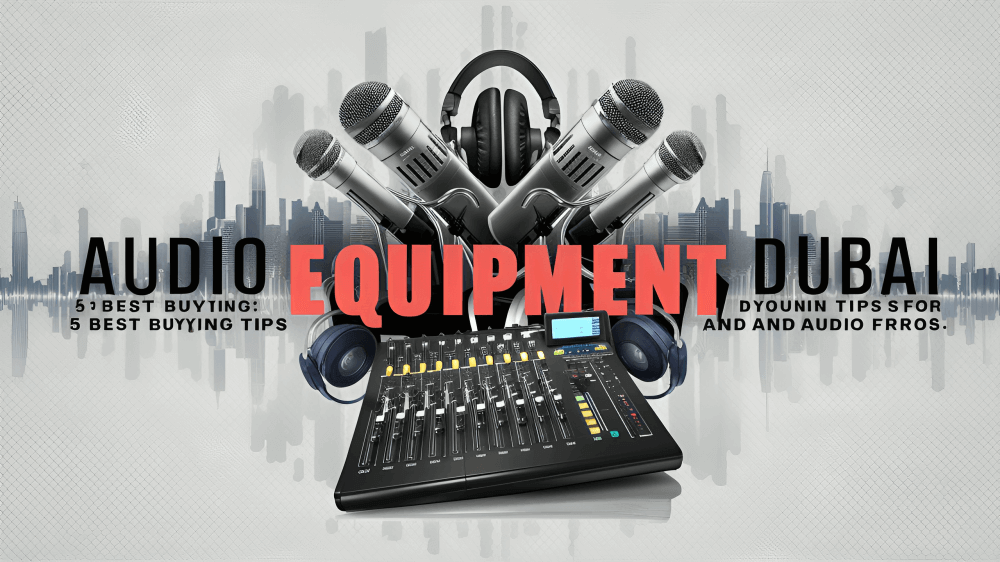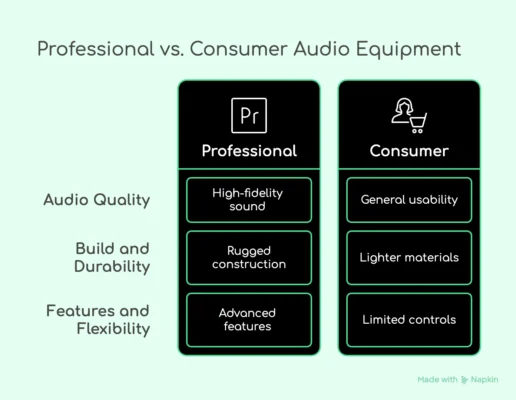Audio Equipment Buying Guide for Podcasters and Audio Pros

Audio Equipment Buying Guide for Podcasters and Audio Pros
In today’s content-driven world, audio quality can make or break your production. It doesn’t matter if you’re an experienced audio engineer, a rising podcaster, or just starting out, investing in the right equipment is critical. Clear, professional-grade sound isn’t just a nice-to-have—it’s essential to building trust and keeping your audience engaged.
With the rapid growth of podcasting and content creation across platforms, the demand for high-performance audio equipment has never been higher. From microphones and interfaces to studio monitors and mixers, having the right gear is what separates amateur results from polished productions.
This guide is your trusted companion to navigating the world of audio equipment in Dubai. We’ll break down the types of gear you need, explain the differences between consumer and professional tools, and help you make smart buying decisions based on your goals, budget, and production style.
Types of Basic Audio Equipment
When it comes to Buying Audio, you’ll need the right Equipment. Here is the basic list of audio equipment that can help you capture, create, and enjoy high-quality sound.
1- Microphones: Microphones come in many shapes and sizes, each designed to meet a particular need. Dynamic microphones are robust and work well for live shows, while condenser mics are better for recording in a studio.
2—Headphones: Headphones are another important element of Audio Equipment. They allow you to listen critically and nuance your recordings or music.
3—Mixers: Mixers give you fine-tuned control over your sound. They take various audio inputs, such as microphones and instruments, and blend them to create a harmonious mix.
4- Audio Interfaces: These devices bridge the gap between your analogue audio gear and the digital world. They convert analogue Audio signals into digital data that your computer can understand.
5—Studio Audio Monitors: Studio monitors are designed to reproduce Audio accurately and clearly. They’re essential for mixing and mastering, as they reveal imperfections in Audio.
6- Cables and Accessories: High-quality cables, such as XLR and TRS, ensure a clean signal path.
Difference Between Professional vs. Consumer Audio Equipment

Understanding the key differences between professional and consumer audio equipment is essential when choosing the right gear for your content creation setup in Dubai. While both serve distinct purposes, their performance, durability, and flexibility vary greatly.
Audio Quality: Professional-grade audio gear is engineered for accuracy, consistency, and high-fidelity sound. It offers a wider frequency response, cleaner output, and minimal distortion—ideal for studios, podcasts, and live production.
Consumer-grade equipment, on the other hand, prioritizes affordability and general usability. It can handle everyday tasks but may lack the clarity and depth needed for professional-level results.
Build and Durability: Professional equipment is made to endure demanding environments. Rugged construction, high-end materials, and long operational life make it suitable for repeated use in studios or on location.
Consumer models may use lighter, less durable materials, making them more susceptible to wear and tear over time.
Features and Flexibility: Pro audio gear offers advanced features such as gain control, phantom power, multiple input/output configurations, and software integration. This flexibility allows professionals to tailor their sound with precision.
Consumer audio products usually offer limited controls and fewer customization options, making them simpler but less adaptable for complex workflows.
In short, if your goal is high-quality production and long-term reliability, professional audio gear is a worthwhile investment. For casual use or entry-level projects, consumer equipment may suffice—but it often comes with compromises.
Why Professionals Should Invest in Professional-Grade Audio Gear
Investing in professional-grade audio equipment isn’t just about upgrading your tools—it’s about delivering consistent, high-quality sound that meets the standards of serious production.
- Superior Sound Quality: Professional gear is designed for clarity, accuracy, and a full dynamic range, ensuring your recordings sound crisp, detailed, and immersive.
- Reliability in Demanding Environments: Built with premium materials and advanced engineering, pro equipment stands up to regular, intensive use without compromising performance.
- System Compatibility: From mixers and interfaces to studio monitors and DAWs, professional equipment integrates seamlessly into advanced audio workflows, giving you full control and scalability.
For creators who value precision and want to produce at the highest level, professional gear is a long-term investment that ensures quality, durability, and creative flexibility.
Buying Guide Buying Guide for Podcasters and Audio Pros
Here’s a step-by-step Quick guide you can trust to help you navigate the process:
- Determine Your Budget: Before buying audio equipment, it’s crucial to establish a budget.
- Identify Your Needs: Consider your specific audio needs. Are you a musician looking to record instruments, a podcaster needing a reliable microphone, or a music enthusiast seeking better sound quality?
- Research and Comparison: Take the time to research different audio equipment options within your budget.
- Read Reviews and User Experiences: One of the best ways to gauge the performance and reliability of audio equipment is by reading reviews and user experiences.
By following these steps, you’ll be equipped to make informed choices when purchasing audio equipment. Remember, your choices should align with your long-term goals, meet your needs, and fit your budget. Now, it’s time to put your knowledge into action and start building your high-quality audio setup!
Frequently Asked Questions (FAQs)
Which Sound Systems Are Best for Podcasting?
The choice of sound systems for podcasting depends on your budget and recording environment. A popular setup includes:
- A good-quality condenser microphone.
- An audio interface.
- Closed-back headphones for monitoring.
What Is Digital Audio Equipment, and How Does It Work?
Digital Audio equipment processes and records Audio in digital format. It converts analog audio signals (sound waves) into digital data using analog-to-digital converters (ADCs).
How to Choose the Right Audio Systems for Specific Needs?
Consider your intended use when selecting suitable audio systems. Assess your needs, budget, and available space before making decisions.
Are Tube Microphones Better Than Condenser Microphones?
The choice between tube and condenser microphones depends on personal preferences and the desired sound. Tube microphones often add warmth and character to recordings, making them famous for vocals and specific instruments. Condenser microphones are versatile and accurately capture sound, making them suitable for various applications.
Can I use studio monitors to listen to regular music?
Yes, you can use studio monitors to listen to regular music.
Do I Need an External Audio Interface for My Computer?
An external audio interface is recommended for professionals and those seeking higher audio quality. Getting the right audio equipment isn’t just about getting new tools; it’s about improving your work, spreading your message, and giving your viewers a full auditory experience. With high-quality gear, professional audio engineers can create sound settings that have a big effect, musicians can be true to their craft, and podcasters can tell their stories.
Check Out Our Authentic Audio Equipment in Dubai Here –
References: The 10 Best Studio Monitors for Music Production of 2024.







